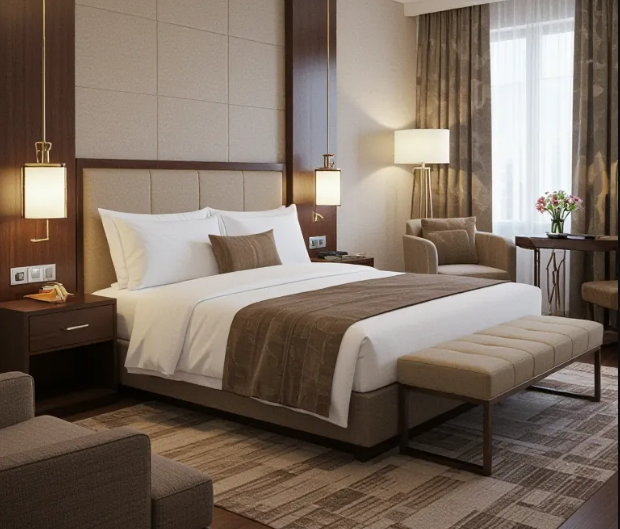In hospitality, a fresh, well-kept hotel does more than look good – it keeps guests returning. The good news? You don't need a huge budget to make your place shine. Smart hotel renovation is about choosing wisely – spending where it counts to attract more guests without overspending. Here’s how to get the best return on every dollar.
Why Budget Renovations Matter for Your Hotel
Guests notice the small stuff—a cracked tile, worn-out curtains, or a squeaky bed. These little issues can make your place feel run-down and lead to bad reviews and fewer return visits. But a smart, low-cost renovation can fix that. It shows guests you care, which builds trust and keeps them coming back. Even better, upgrades like better lighting or a more efficient AC can save you money over time.
What’s the Difference Between Renovation and Remodelling
First, let’s clear up a common mix-up: renovation vs. remodelling.
- Renovation is basically fixing up what's already there. Like painting walls, swapping out old lights or faucets, or patching things. It’s about freshening things up without moving walls or changing the room's basic shape.
- Remodeling is bigger. Think knocking down walls to make a bathroom larger, or adding a whole new window. It changes the actual space. But it usually costs more and takes longer.
For most hotels watching their budget? Stick with renovation. It’s quicker, cheaper, and still makes a real difference guests will notice.
What Time to Renovate
How do you know when it’s time to roll up your sleeves and start renovating? Keep an eye out for these red flags.
- Persistent Guest Complaints: Recurring issues like dim lighting or uncomfortable beds signal urgent needs.
- Visible Wear and Damage: Stained carpets, peeling paint, or torn upholstery create negative impressions.
- Outdated/Non-Functional Fixtures: Rusty showerheads, loose doorknobs, or broken switches feel neglected.
- Minor Maintenance Neglect: Accumulated small issues (sticky drawers, cracked tiles) degrade perceived quality.
- Rising Operational Costs: Skyrocketing utility bills point to inefficient appliances or poor insulation.
Key Takeaway: These recurring complaints and visible flaws directly impact guest satisfaction and your bottom line, making them prime candidates for targeted, budget-friendly renovations.
Understanding the Costs
Let’s talk numbers. How much should you expect to spend?
There are many factors that affect the cost of hotel renovation. There is no fixed cost, but you can refer to basic guest room renovation, costs range from roughly 8,000 - 40,000 USD per room. Of course, hotels are of different sizes and budgets are also different:
- Economy hotels: Stick to the lower end with fresh paint, new linens, and updated light fixtures.
- Mid-range properties: May add new flooring or bathroom upgrades, pushing costs higher.
- Luxury hotels: Can splurge on high-end materials but still find budget-friendly alternatives.
What drives these costs?
- Labor: 30–40% of your budget.
- Materials: 20–30%.
- Design fees (if hiring a pro) and unexpected issues (e.g., hidden water damage): The rest.
Always set aside 10–20% of your budget for surprises—this prevents panic when unplanned issues pop up.
A Step-by-Step Plan for Budget Renovations
1. Walk Through and Assess
Take a walk through your property and make a list of visible issues—from broken fixtures to tired decoration. Prioritize based on guest impact. Comfort-related problems like a faulty air conditioner should take precedence over minor aesthetic details.
2. Phase the Renovation
Avoid shutting down your entire property. Work on one area, floor, or set of rooms at a time. This strategy keeps revenue flowing and minimizes disruption.
3. Schedule Smartly
Plan renovation work for off-peak seasons. For beachside hotels, winter may be quieter; for urban properties, business travel may slow during summer. Timing work to slower periods reduces guest dissatisfaction and lost income.
4. Keep Guests Informed
Update your website and include messages in booking confirmations to let guests know about ongoing improvements. Phrases like “We’re upgrading our spaces to serve you better” set a positive tone and help manage expectations.
5. Control Room Inventory
Use your property management system to block off rooms under renovation to prevent accidental bookings. This ensures smoother operations during construction and avoids negative guest experiences
Cost‑Saving Renovation Strategies
Refresh instead of replace:
Give old wooden dressers new life with fresh paint. Re-cover chairs with worn fabric instead of tossing them. It saves money and keeps your hotel's unique character.
Pick tough, budget-friendly materials:
Luxury vinyl tile (LVT) looks like wood but costs less and cleans easily – perfect for busy areas. Use acrylic tubs in bathrooms; they’re cheaper than porcelain but just as strong.
Focus where guests look:
Put your money into guest rooms and lobbies – spaces visitors actually use. Staff areas like break rooms can wait.
Hire local pros:
Local contractors know area building rules, helping you avoid expensive errors. They don’t charge travel fees either. Always check their reviews and references first – bad work costs more later.
Save money with eco-upgrades:
Switch to LED bulbs – they last longer and slash energy bills. Install low-flow showerheads and toilets to cut water costs. Smart thermostats that adjust when rooms are empty save even more.
Buy bigger, save more:
Order paint, tile, or fixtures in bulk for better prices. Partner with nearby suppliers for bigger orders and bigger discounts.
Do simple jobs yourself:
Save on labor by handling easy tasks: hanging art, replacing curtains, or installing outlet covers. It adds a personal touch too.
Track your results.
After renovations, keep an eye on guest reviews. Are they mentioning the new beds or brighter rooms? Check booking rates—did they go up? Compare utility bills to see if your green upgrades are paying off. Use what you learn to guide future renovations—what worked once might work again.
Final Thoughts
Renovating your hotel on a budget isn't about doing things cheaply. It's about smart choices that make your place better and save you money. Focus on updates guests notice, grab good-value materials, and plan well. You can create a clean, welcoming feel without blowing your budget.
Remember: Satisfied guests lead to more bookings, better reviews, and higher profits. So start small – maybe just one project. Tackle it well, and you'll see the difference it makes. Your guests will feel it, and your business will grow.

